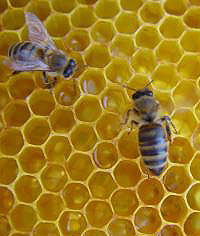Clinical
Specialties: Apitherapy
Royal Jelly
 Royal jelly is a milky substance that worker bees produce in their salivary glands. All bee larvae are fed royal jelly for the first three days of life. After that only the larva designated to be the queen is fed royal jelly. The components of royal jelly help her mature into a fertile and longer-living bee. Whereas worker bees live from 4-6 weeks, the queen lives up to 6 years and lays 2.5 times her weight in eggs a day. Royal jelly is a milky substance that worker bees produce in their salivary glands. All bee larvae are fed royal jelly for the first three days of life. After that only the larva designated to be the queen is fed royal jelly. The components of royal jelly help her mature into a fertile and longer-living bee. Whereas worker bees live from 4-6 weeks, the queen lives up to 6 years and lays 2.5 times her weight in eggs a day.
Royal jelly has played a key role in traditional Chinese medicine, and is still used today to prevent and ameliorate a wide variety of medical conditions. These include, but are not limited to: anxiety, arteriosclerosis, arthritis, bone fractures, asthma, depression, fatigue, lack of sexual desire, hair loss, impotence, insomnia, liver and kidney disease, stomach ulcers, menopausal symptoms, varicose veins, a weak immune system, high and low blood pressure, and a variety of skin conditions. Royal jelly, which is high in B vitamins, has a metabolic stimulating action, aiding in the breakdown of proteins, carbohydrates, and lipids. Additionally it helps promote collagen production. It can also increase oxygen consumption and decrease levels of free radicals that cause aging. Royal jelly has a direct effect on the adrenal glands leading to an increased secretion of adrenaline that can be cardioprotective. With its protective effects on the cardiovascular and immune systems and it’s anti-aging properties, it is no wonder royal jelly is a prized commodity in many cultures.
The effects of royal jelly on specific conditions may be amplified when taken in combination with other bee products. Another more recently found function of royal jelly is providing protection against the negative side effects of chemo and radiation therapies, especially when given with propolis. This combination can also be used with positive effects for viral infections including shingles.
While there is still much to be learned about royal jelly, some very relevant studies have shown how effective it can be. A Japanese study found that royal jelly produced an antifatigue effect in exercising mice. In China and Russia, royal jelly was effective in treating chronic viral and bacterial infections, anorexia, varicose veins, and stomach ulcers. During a flu epidemic in Yugoslavia, it was noted that those who consumed royal jelly daily were less likely to get the flu. Another study done in Egypt in 1995 revealed that royal jelly was capable of killing several bacterial cultures, including E. coli. Also in 1995, it was found that people taking 50-100 milligrams of royal jelly per day decreased total serum cholesterol by 14% and lipids by 10%. Dr. Kochan uses royal jelly, which he has seen first hand to promote collagen synthesis, to aid in healing from prolotherapy treatments or other injuries, as well as to help prevent and treat viral infections.
|
